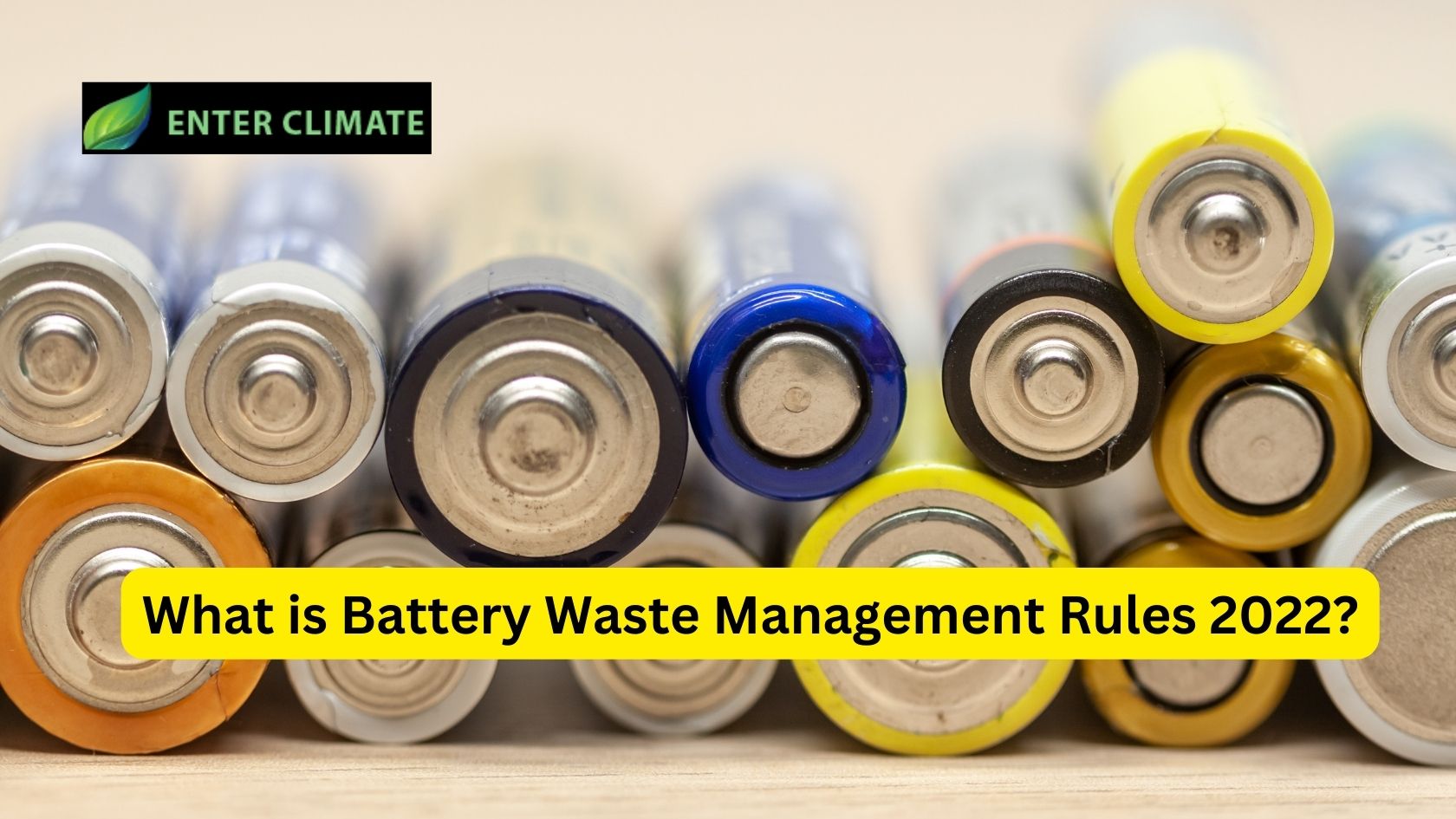The growing use of batteries across various industries has sparked serious concerns about their environmental impact, especially when disposed of improperly. Batteries contain hazardous substances like mercury, lead, and cadmium, which can cause significant harm to the environment and human health if not handled properly. To address this issue, new battery waste management rules were introduced in 2022 to establish a more sustainable and eco-friendly approach to battery disposal and recycling.
These rules aim to regulate how businesses and individuals handle used batteries, ensuring their safe disposal, recycling, and recovery of valuable materials while minimizing environmental damage. In this blog, we will explore the battery waste management rules of 2022, their significance, and how they impact businesses, consumers, and the environment.
Why Are the 2022 Battery Waste Management Rules Important?
Batteries are everywhere—powering our phones, laptops, cars, and even energy storage systems. As the demand for battery-powered devices grows, so does the need for effective battery waste management. Without proper recycling and disposal, the accumulation of battery waste can lead to:
- Environmental Pollution: Hazardous substances in batteries can leak into the soil, water, and air, leading to long-lasting damage to ecosystems.
- Safety Hazards: Improper disposal, especially of lithium-ion batteries, can cause fires or explosions, posing a risk to workers, waste management personnel, and communities.
- Waste of Valuable Resources: Batteries contain precious metals like cobalt, nickel, and lithium, which are highly valuable and can be recovered through recycling.
The battery waste management rules 2022 are designed to address these challenges by setting clear guidelines on how batteries should be disposed of, collected, recycled, and treated. By following these regulations, businesses and consumers can play a part in reducing the environmental impact of batteries.
Key Features of the 2022 Battery Waste Management Rules
The battery waste management rules of 2022 introduce several key provisions aimed at improving the collection, recycling, and safe disposal of batteries. Below are some of the most important aspects of these rules:
1. Extended Producer Responsibility (EPR)
One of the major components of the 2022 battery waste management regulations is the concept of Extended Producer Responsibility (EPR). Under EPR, manufacturers and importers of batteries are required to take responsibility for the entire lifecycle of their products, including the safe disposal and recycling of used batteries.
Businesses that produce or sell batteries must set up a system for the collection, recycling, and safe disposal of used batteries. This may include partnering with recycling companies or setting up collection points where consumers can drop off their used batteries for proper disposal.
2. Collection and Recycling Targets
The 2022 rules also set specific collection and recycling targets for battery waste. These targets vary depending on the type of battery and the region, but they generally aim to:
- Increase the collection rate of used batteries
- Ensure that a certain percentage of batteries are recycled, reducing the need for new raw materials
- Promote the recovery of valuable materials, such as lithium, cobalt, and nickel, to be reused in new batteries
By setting clear recycling goals, the rules aim to create a more sustainable battery waste management system and reduce reliance on mining for new resources.
3. Mandatory Labeling and Reporting Requirements
To improve transparency and traceability, businesses are required to label batteries with information about their recycling options and potential hazards. This helps consumers understand how to safely dispose of the batteries and encourages them to recycle rather than throw them away.
Additionally, manufacturers and importers must report the quantities of batteries they produce, sell, and collect for recycling. This data helps regulators monitor compliance with recycling targets and ensures that the system is working effectively.
4. Battery Recycling Infrastructure and Awareness
The new rules also focus on building a robust infrastructure for battery collection and recycling. This includes establishing more collection points in public spaces, retail stores, and workplaces. Businesses are also encouraged to raise awareness about the importance of battery recycling through educational campaigns.
5. Special Provisions for Hazardous Batteries
Certain types of batteries, such as lead-acid and lithium-ion batteries, pose a higher risk due to their toxic content and potential to catch fire. The rules include specific provisions for the collection, transportation, and disposal of these hazardous batteries to minimize safety risks.
6. Penalties for Non-Compliance
To ensure that businesses adhere to the new rules, penalties have been introduced for non-compliance. Companies that fail to meet collection and recycling targets, or who do not properly label their products, may face fines and other regulatory actions.
How Do the 2022 Battery Waste Management Rules Impact Businesses?
The introduction of the battery waste management rules in 2022 brings both challenges and opportunities for businesses. Here’s how these regulations affect companies:
1. Increased Responsibility for Producers
Manufacturers, importers, and retailers now bear greater responsibility for the entire lifecycle of the batteries they sell. Businesses will need to establish collection and recycling programs, and may need to partner with certified recycling facilities to ensure compliance with the new rules.
2. Additional Costs for Compliance
While these regulations are designed to benefit the environment in the long run, businesses will need to invest in infrastructure and systems to comply with the rules. This could include costs related to setting up collection points, working with recycling companies, and reporting on battery disposal.
3. Opportunities for Sustainable Branding
Adhering to the battery waste management rules can enhance a business’s reputation as a sustainable and environmentally responsible company. Many consumers are becoming increasingly conscious of environmental issues, and businesses that demonstrate their commitment to sustainability may enjoy a competitive advantage.
4. Better Resource Management
The recycling provisions of the 2022 rules encourage businesses to recover valuable materials from used batteries. This can help reduce dependence on raw materials, lower production costs, and contribute to a circular economy.
How Can Consumers Contribute to Battery Waste Management?
Consumers also play a crucial role in the success of battery waste management initiatives. Here are some steps that individuals can take to ensure proper disposal and recycling of batteries:
- Use Battery Recycling Bins: Look for collection points at local retailers, electronics stores, and public spaces. Many stores now provide bins specifically for battery recycling.
- Educate Yourself About Battery Types: Different types of batteries require different disposal methods. Be sure to read labels and understand the recycling options for the batteries you use.
- Avoid Throwing Batteries in the Trash: Batteries should never be thrown in the trash, as they can leach toxic substances into the environment. Always recycle batteries at certified collection points.
The battery waste management rules of 2022 are a critical step in promoting sustainability, reducing environmental risks, and ensuring the responsible disposal of used batteries. By understanding and following these regulations, businesses and consumers can play an active role in protecting the planet while benefiting from more sustainable resource management.
FAQs
1. What is Extended Producer Responsibility (EPR) in battery waste management?
Extended Producer Responsibility (EPR) is a key aspect of the 2022 battery waste management rules. It holds manufacturers, importers, and retailers responsible for the entire lifecycle of their products, including the disposal and recycling of used batteries. This encourages businesses to take an active role in minimizing the environmental impact of battery waste.
2. What penalties can businesses face for non-compliance with the 2022 rules?
Businesses that fail to comply with the battery waste management rules may face fines, penalties, and other regulatory actions. These could include failing to meet collection or recycling targets, not providing proper labeling, or not adhering to safety standards for hazardous batteries.
3. How can businesses get started with compliance for battery waste management?
To comply with the 2022 rules, businesses should start by identifying the types of batteries they use and sell, establishing a collection system for used batteries, partnering with certified recycling companies, and ensuring that they meet all reporting and labeling requirements. It’s important to stay informed about local regulations and deadlines.









